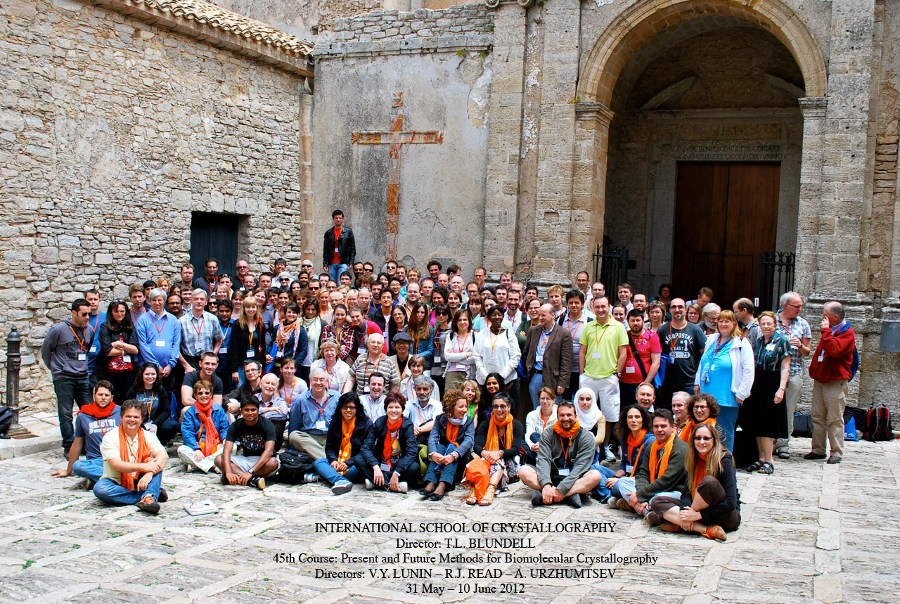
Click on the photo for a printable version
A REPORT
International School of Crystallography
Present and Future Methods for Biomolecular Crystallography
31 May – 10 June 2012
The 45 th course of the International School of Crystallography was held, as every year, in Erice , Italy at the Ettore Majorana Foundation and Centre for Scientific Culture. The course included a total of 141 participants from 31 countries. The programme included a total of 56 lectures, including 7 chosen from poster abstracts submitted by participants. In addition, there were 4 software demos and 11 different tutorials (each repeated twice). The participants presented a total of 90 posters in two poster sessions, each of which was preceded by short oral presentations. Poster preview sessions (accompanied by a pizza or pasta buffet) provided an extra opportunity to mingle around the posters. As always, the international composition of the school, as well as the friendly and informal atmosphere of Erice played an important role in facilitating the communication between students and teachers, and encouraged a lot of interaction among participants, rewarded this year by the determination of at least three new structures during the school.
Objective
The main objective of the Institute was to equip the next generation of scientists with a deep understanding of the tools they need to solve challenging structural projects and an appreciation for what the future holds.
Lecturers
Lecturers were chosen from world leaders in the field of structural biology, and all made great efforts to present cutting edge science at a level accessible to participants with limited experience. Most presented two lectures, one focussed on methodology and the other illustrating the structural insights that can be obtained using their methods; many lecturers also presented a demo or tutorial.
Programme
The course concentrated on single-crystal X-ray diffraction, covering all aspects of structure determination, from protein production (Stephen Kent, Todd Yeats), to crystal preparation (Martin Caffrey) and data collection and analysis (Sean McSweeney, Kay Diederichs, Elspeth Garman Tatiana Petrova and Dominika Borek), to structure solution (Randy Read, Isabel Uson, Zsbyszek Dauter, Tim Gruene, Felix Frolow, Clemens Vornhein and Vladimir Lunin) and validation (Jane Richardson and Zbyszek Otwinowsky). Different approaches for solving the structures were also presented by Tom Terwilliger, Tassos Perrakis, Paul Emsley, Pavel Afonine, Garib Murshodov and Axel Brunger. In addition, the horizons were broadened with a number of complementary approaches, including X-ray free electron lasers, neutron diffraction and small-angle X-ray scattering (Nobuo Niimura, Petra Fromme, Pierre Thibault, Frank DiMaio, Tatiana Latycheskaia and Dmitri Svergun). Jaime Prilusky showed how the structure obtained can be presented to the world through the Protopedia website, challenged the participants to prepare their own Proteopedia pages during the course.
A number of speakers presented the structural fruits of their research: complement proteins (Piet Gros), Z-DNA at 0.55Å resolution (Zbyszek Dauter), enzymes mutated in lysosomal storage diseases (Randy Read), viral membrane fusion proteins (Felix Rey), monoamine oxidase inhibitors (Andrea Mattevi), proteins involved in Ca-triggered vesicle fusion (Axel Brunger), retropepsin (Mariusz Jaskolski), autotaxin (Tassos Perrakis), and the eukaryotic ribosome (Sergey Melnikov). All the talks made available by the speaker can be found at the following address: http://erice2012.docking.org/vcourse/
A special session commemorated the great contributions of three crystallographers who passed away recently: Lodovico Riva di Sanseverino (the linchpin of the Erice schools for many years), Herb Hauptman (direct methods) and David Sayre (direct methods and coherent diffraction imaging). Contributions were made by Davide Viterbo (who knew all three), Paola Spadon, Randy Read and Pierre Thibault, who uploaded the first Wikipedia article about David Sayre in front of the audience.
Awards and participants feedback
Several prizes were awarded during the course. The prize for best poster presentation was given to:
Denise Cavalcante Hissa ( Federal University of Ceara, Graz, Austria), with a special mention to Andrea Pica (University of Naples “Federico II”, Italy);
the winners for the best Protopedia page were:
Wee Lee Chan (University of Cambridge, UK) and Tomas Klumper (Masaryk Univerzity, Czech Republic);
the Lodovico Prize for the most active participant, inside and outside the lecture hall, was awarded to:
Abhay Kotecha (University of Oxford, UK) and a special mention was awarded to Marcus Fislage (Vrije Universiteit Brussel, Belgium).
( Click on the photo for a printable version)
Participants awarded during the closing ceremony. From right to left: Abhay Kotecha, Denise Cavalcante Hissa, Andrea Pica, Wee Lee Chan,
Paola Spadon, Tomas Klumper, Annalisa Guerri, Marcus Fislage, Vladimir Lunin, Jaime Prilusky, Sacha Urzhumtsev and Randy Read.
After the school, a large number of participants gave feedback by filling in a detailed questionnaire. They were unanimous in agreeing that a similar meeting should be held in the future, with the vast majority (99%) believing it should be held within the next 4 years. The majority considered the course to have been very successful (91%) in most of its objectives. There was some very helpful feedback, and the organizers of the next course should consider whether it would be good for instance to have a few more talks that concentrate on the underlying theory or to provide more coverage for topics such as crystallization. A complete survey of the questionnaire can be found here.